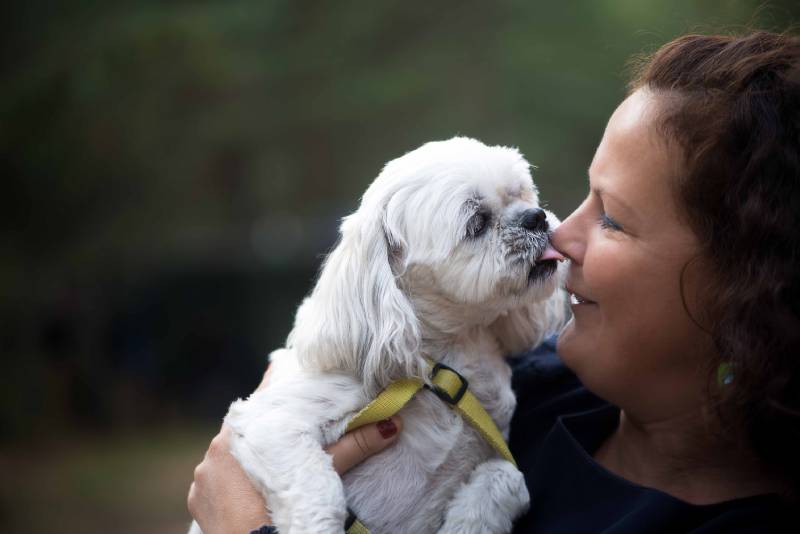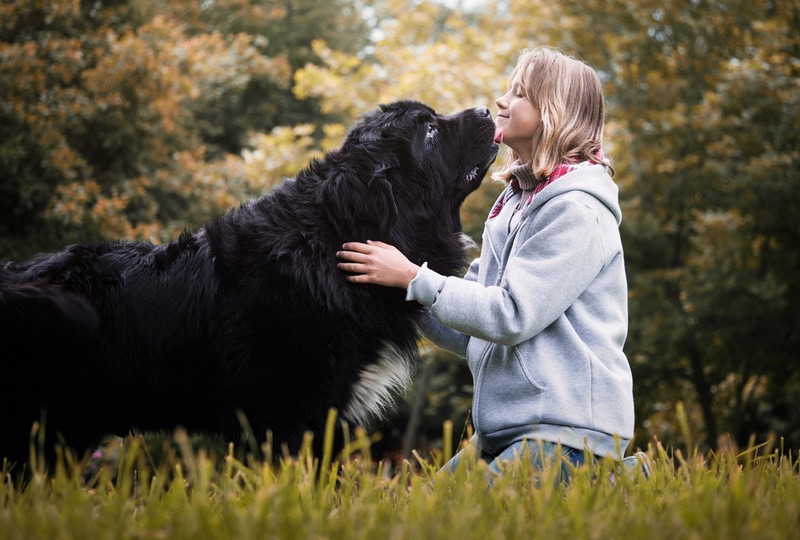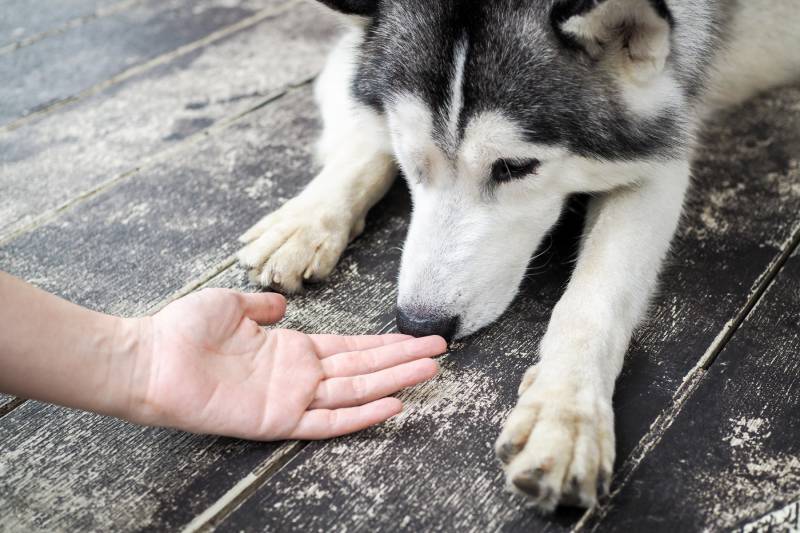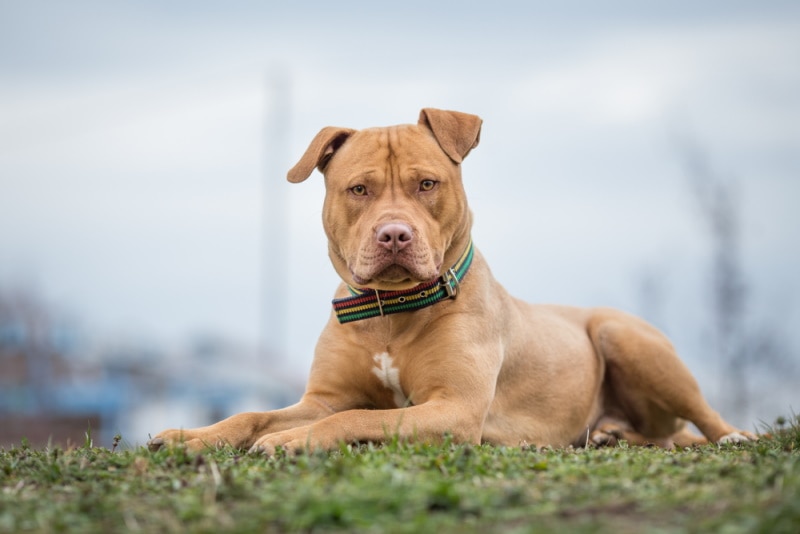How to Communicate With a Deaf Dog: 8 Vet-Approved Tips & Tricks
Updated on

If you’ve ever spent time with a deaf dog, then you know that the interactions with deaf dogs are often very different from ones with dogs that can hear. Deaf dogs have a high reliance on their remaining senses, but they aren’t able to hear things like commands and dangers.
Because of their inability to hear, creativity is often required when communicating with a deaf dog. The training process requires patience with the dog and yourself. If needed, a trainer who specializes in training deaf dogs may need to assist you. To get you started on effectively communicating with your deaf dog, here are some tips and tricks you need to know.
How to Communicate With a Deaf Dog
1. Visual Check-ins
Check-ins are a valuable behavior you can train your deaf dog to perform. This behavior essentially means that your dog naturally looks to see where you are and what you’re doing. They should be doing visual check-ins as frequently as every minute or two if you’re doing an activity together or you’re out of your own house or yard. If the two of you are just lounging around the house, your dog should check to see where you are at least every few minutes or so while they’re awake.
This behavior is great for deaf dogs to learn because it teaches your dog how to be visually reliant on you for commands. No amount of hand signals or waving will be effective if your dog never looks at you. Start by giving your dog a treat every time they look at you, ensuring they associate you with good things to the point that they routinely want to check to see if you’ve got anything tasty to offer.
2. Hand Signals
One of the most common training techniques for deaf dogs is teaching them basic hand signals. Hand signals are trained in much the same way as teaching a hearing dog to perform an auditory command. You’ll provide rewards when your dog performs the hand signal command you’ve given to them.
Make sure to choose hand motions that are different enough from each other that your dog won’t become confused and get commands mixed up with each other. You can teach your dog to perform just about any command via hand signals, but make sure your dog has a solid grasp of basic obedience commands, at minimum.

3. Stomping
Although they’re deaf, your dog can feel vibrations occurring in their environment. In fact, their sense of touch and ability to feel vibrations may be slightly enhanced due to the loss of one of their main senses. If you’re struggling to get your dog’s attention from a short distance, stomping can create enough vibration on the floor to get your dog’s attention.
Obviously, this doesn’t work on solid ground or any type of floor that doesn’t allow for any movement from stomping. This can be a good way to encourage your dog to look at you, though. If they begin to look around for the source of the vibration, then you’ll be able to get your dog’s attention with hand signals or other communication techniques.
4. Waving
The simplest way to try to communicate with your deaf dog is to wave your arms. Even in dogs not trained to respond to waving, most dogs will look to see what you’re doing if they catch sight of you waving your arms all over the place. Waving can be effective for getting your dog to look at you and allow you to give them an additional command or get them to come to you.
Waving is a good option when your dog is awake, but it definitely isn’t going to be effective if your dog is asleep! It also is unlikely to work well with a dog that is thoroughly distracted by some sort of visual or olfactory stimuli. It works best when used in conjunction with skills like visual check-ins.

5. Flashing Lights
Since deaf dogs can’t be trained with a clicker, you may have to get creative to “mark” desirable behaviors before you can get a treat out of your pocket and to your dog. Using a flashlight to quickly flash on and off in place of a click can be an excellent way to mark behaviors in a dog that can’t hear.
You can also use flashing lights in situations where you are struggling to get your dog’s attention and you don’t want to startle them. For example, if your deaf dog is asleep, they may be prone to startling, potentially even becoming nippy, if you touch them to wake them up. Flashing the lights in the room on and off a few times will likely wake your dog up in a way that is far less jarring than being touched.
6. Touch
Although it can be startling for some deaf dogs to be touched when they aren’t expecting it, touch is a valuable sense that your deaf dog has. Touch can allow them to better understand their environment, allowing them to better determine the safety and purpose of items. Touch can be used as an effective tool in providing commands to your dog. It can also help build trust between you and your dog. Petting and affection are great ways to build trust between any person and their dog, and deaf dogs are no exception.
Just remember to respect your dog’s personal space and listen to their body language and cues that indicate if they are becoming uncomfortable with the interaction. Also, keep in mind that touch isn’t the safest way to get the attention of a sleeping dog. If your dog is prone to startling, it’s best to find another way to wake them up to avoid being nipped or scaring them, causing distrust.

7. Visual Updates
If your dog is able to visually keep track of you, then they are more likely to “listen” to commands and less likely to become startled by your presence. To use visual updates with your dog, all you need to do is make sure your dog sees what you’re doing. This means that when you get up to leave the room, make sure your dog sees you leave the room. If you’re going to work, make sure your dog sees you go out the front door. If your dog sees you coming and going, then they will likely be more comfortable and trusting.
Sometimes, deaf dogs may wake up and be somewhat disoriented if things have changed significantly around them while they slept, but if your dog sees you leave the room and then chooses to stay in that empty room to nap, they likely won’t be concerned about your whereabouts when they wake up.
8. Vibration Collars
Using a collar that produces gentle vibrations can be an exceptionally effective way to get your dog’s attention and encourage them to look at or come to you. Simply give them a gentle buzz of the collar. During training, reward your dog every time they look at you when they feel the buzz. Over time, this behavior will become ingrained in your dog, ensuring they look to find you whenever they feel the vibration.
It’s important that you choose a collar that is made to gently get your dog’s attention. Shock collars and other collars that are intended to deter behaviors should not be used. These collars can lead to distrust from your dog, and they’re also likely to create anxiety and potentially reduce obedience.

Keeping Your Deaf Dog Safe
There are a handful of skills that are essential to maintaining the safety and health of your deaf pup. Recall and obedience are basic skills that can help you get your dog out of an unsafe situation quickly if you have already trained them to respond to something specific, like waving or a collar vibration. For deaf dogs that lack basic obedience and recall skills, it’s very possible for them to end up in dangerous situations that could otherwise be avoided. Remember that your deaf dog can’t hear the dangers around them like snakes and cars.
If you take your deaf dog outside of a fenced yard, they should be on a leash. In some situations, a long line leash may be appropriate to keep your dog safe while allowing them freedom of movement. If you’re taking your dog for a walk around the neighborhood, a regular leash should be used. Leashing allows you to control where your dog is going, including giving you the ability to quickly remove them from dangerous situations.
Conclusion
While training a deaf dog poses a unique set of challenges, using a combination of these methods can be extremely useful in creating desirable behaviors in your dog. There’s absolutely no excuse for the average deaf dog to not be trained in basic obedience and recall skills.
The vast majority of dogs are able to learn these skills, including deaf dogs. It simply requires you to provide more creative and slightly different training methods from what you’re used to with a hearing dog. When all else fails, consult a trainer who is experienced in training deaf dogs to help you and your pup in your training journey.
Featured Image Credit: Zelma Brezinska, Shutterstock












